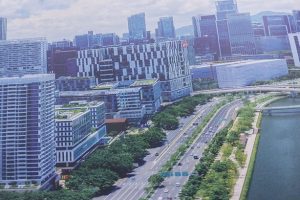
BY DARGIE KAHSAY
The rapid rate of urbanization and the urban population growth are becoming additional factors for climate change. The proper management of urban activities and comfortable urban life depends on urban planning. Appropriate urban planning is believed to consider residential areas, road and green spaces with a set standard. But, only appropriate urban planning is not enough to promote the sustainability of the environment, promoting eco-friendly and environmentally conscious green structures are equally important in urban centers.
According to professionals from the architecture sector environmentally conscious structure is a crucial element for societal, resource and economic sustainability in the fast growing urbanization. The architects explain that each building and construction should consider the sustainability of the environment, the resource and the society by implementing all necessary measures starting from the design of the structure. A building or any construction since its inception uses resources that have an implication in the society, environment and the economy.
Recently the architects have forwarded important suggestions in a panel discussion entitled “Environmentalism and Green Design in Architecture and Urban Development,” organized by Green Ethiopia, a voluntary youth-based organization. During the panel discussion which focused on the current trends and future prospects of the architecture sector in Ethiopia, the panelists underlined that implementing eco-friendly green architecture is a must for environmental and societal sustainability. Green architecture is not only limited for considering green space or vegetation, according to the professionals in the architecture sector; it is all about the sustainability and efficiency of the buildings from the design until the output.
“For the efficiency of buildings and for the sustainability and suitability of the building with the environment, promoting green architecture is a timely act” said Elshaday Girma, Environmental Engineer and Founder of Green Ethiopia during the opening of the panel discussion. For her, the construction sector in Ethiopia has huge limitations in giving attention to environmentally friendly buildings. For Elshaday giving priority for nature is a precondition for sustainable growth.
According to Elshaday, in addition to giving enough spaces for green areas and plantation, materials used for a building, the energy it uses, the water and sanitation systems are also key in affecting the environment and climate change either negatively or positively. The energy consumption, the water consumption, the sanitation system and even the materials used for the construction of any building are equally important in maintaining sustainable environment.
On his part, Elias Ayalew, Architect, Lecturer and founder of Breeze Consultancy, during the panel discussion stressed that green architect has its own elements and the aim is to achieve the effectiveness and efficiency of the building for the environment. Sustainability, according to Elias, is a relationship between the building on one hand and the society, resource and economy on the other hand. Hence, green architecture starts from the design and inputs used for the construction until the completion of the building should be clean and eco-friendly. It is all about using available resources wisely, efficiently and effectively.
According to Elias green architecture is all rounded initiatives of the professionals in the sector to minimize all environmental harms of a construction through appropriate and scientific designs and implementing the designs properly. Eco-friendly green architecture uses innovative methods for the sustainability of the building without compromising the comfort of the environment and it is all about preserving the future generation’s resources.
Every construction uses resources such as energy, water and materials during and after the construction. Architects should use all possible means to construct buildings which can save and conserve the limited natural resources, Elias underlined. “To wisely use the limited resources including land, the action starts from the design,” Elias stated adding that “each and every building should apply all possible means to minimize the buildings impacts on the environment, the society and the resources.” As to him, through appropriate professional designs, it is possible to save energy and water usage for the building, during the construction and after the completion.
The design of a building can contribute for the efficient use of the available renewable energy at hand using less through healthy means without affecting the comfort of a building. Similarly, it is possible to increase water efficiency and to reserve more.
Rockstone Ethiopia Real Estate Project Director, Adiyamseged Eyassu, on his part argued that green architecture is not a luxury; it is a must to ensure the sustainability of healthy environment. Urban centers are becoming major causes of environmental pollution and climate change; hence, the buildings should consider all the possible means to minimize the environmental effects. In this regard, according to Adiyamseged, Rockstone is introducing eco-friendly building both in giving due attention for green areas and in wise use of resources.
Cost expensiveness, knowledge gap, shortage of latest technology and attitude are among the factors to implement green architecture in Ethiopia. According to the panelists, Addis Ababa buildings are water intensive, energy consuming and mostly environmentally unfriendly due to several factors. Though, according to the experts, the issue of cost is believed to be the factor to construct green buildings, through professional designs, it is possible to build green architecture.
Professional designs of buildings that consider the sustainability of the environment and natural resources is a key for the physical form, economic functions and social impacts of the urban environment. Hence, considering in mind the eco-friendly architecture needs both policies from the government and professional commitment of architects.
The Ethiopian Herald 31 August 2022





